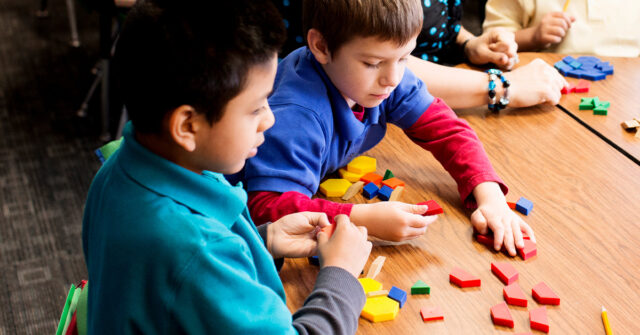
Editor's note: This post is an excerpt from, "Research Foundations: Evidence and Efficacy," a comprehensive report on the impact of diverse intervention strategies with Do The Math from Math@Heinemann. It's been lightly adapted for format. All research citations can be accessed in the linked full report.
***
Since its inception over 15 years ago, Do The Math® has fostered student engagement in math and provided support for teachers in thousands of classrooms across the United States.
Editor's note: This post is an excerpt from, "Research Foundations: Evidence and Efficacy," a comprehensive report on the impact of diverse intervention strategies with Do The Math from Math@Heinemann. It's been lightly adapted for format. All research citations can be accessed in the linked full report.
Since its inception over 15 years ago, Do The Math® has fostered student engagement in math and provided support for teachers in thousands of classrooms across the United States.
A Long History of Turning Research into Practice
Do The Math was initially published in 2008. The program is based on nearly 50 years of research and experience by Marilyn Burns working with teachers and students in the classroom. Marilyn Burns, along with a team of Math Solutions® instructors with extensive classroom teaching experience, created the lessons in Do The Math. They discussed, wrote, debated, tested, rewrote, and refined the lessons to ensure that the content, pacing, and scaffolding were on target to meet the needs of struggling students. She continues to teach regularly in classrooms, finding the experience essential for developing and testing new ideas and materials. The program was initially intended to provide intervention for students who had fallen behind, yet many teachers reported using the modules in a wide variety of settings including whole-class instruction. The lessons are effective for building all students’ understanding, skills number sense, and engaging them with the mathematical practices.
Do The Math shifts the focus of instruction from simply covering content to uncovering essential math content (Burns, 2014). With this new focus the challenge of the teacher is not about finding better ways to explain new content but rather finding better ways of asking students to make sense of what they are learning for themselves (Burns, 2014). This shift from telling to asking is infused throughout all of the modules that comprise the Do The Math program.
The modular design of Do The Math provides flexibility, allowing for the program to be implemented in small-group settings to support struggling students, or in whole-class settings to build numerical understanding and reasoning skills. This flexibility also allows for it to be used in a variety of settings such as classrooms, resource rooms, extended day, and after school programs. The program can be used to supplement on-grade level instruction as well as an intervention for students who are multiple grade levels behind. The program aligns to Response to Intervention (RTI), a national framework for instruction and intervention.
The current version of Do The Math retains the core research principles from the original program and expands and enhances them with the use of lessons learned and the effective leveraging of current technologies. Now available for all tablets, the new Do The Math experience provides teachers and students with easy access to all lessons, interactive visual models, and games to engage and challenge learners within and beyond the walls of the classroom. Students have the flexibility to explore, make mistakes, and have fun with the range of tools and games designed to build their fluency and understanding of key concepts. Teachers can refine their instructional practices using a library of point-of-use resources designed by Marilyn Burns and Math Solutions.
Do The Math rebuilds critical mathematical foundations for understanding by:
- Developing understanding of key concepts and skills with whole numbers and fractions— the essentials necessary for students to succeed in algebra and higher-level mathematics.
- Providing lessons that balance developing understanding and learning procedures.
- Strengthening students’ ability to make sense of concepts, solve problems, reason, and use appropriate tools.
- Extending student practice and further increasing engagement through new online tools and interactive games.
Do The Math Program Contents
Designed to support struggling students in Grades 1–5+, Do The Math is organized into 13 scaffolded modules that focus on whole numbers and fractions. Each module contains 30 lessons. Students receive an assessment every fifth lesson to monitor progress. Additionally, students take a beginning- and end-of-module assessment to monitor growth.
ADDITION & SUBTRACTION
Number Core
Number Core supports students’ success by rebuilding the foundations of Numbers and Operations. Students develop mental representations of quantity using the benchmark number of 5 and then 10, learn to think flexibly about how to compose and decompose numbers, and build facility with figuring sums to 20.
Addition & Subtraction A: Addition with Sums Up to 100
Addition & Subtraction A builds a foundation for addition using two of the big ideas of mathematics: 10 is an organizer for the base-ten number system. Numbers can be composed and decomposed. These big ideas help students to build place-value understanding and make sense of meaning behind the addition facts and calculations involving regrouping.
Addition & Subtraction B: Subtraction with Sums Up to 100
Addition & Subtraction B reinforces subtraction and addition as inverse operations. The major emphasis of this module is on helping students recognize the three meanings of subtraction in real-world contexts: takeaway, missing part, and comparison. Students also learn three ways to compute differences between numbers from 0 to 100, and how to flexibly apply these strategies to solve contextual problems involving subtraction.
Addition & Subtraction C: Numbers Greater Than 100
Addition & Subtraction C applies and extends the big ideas, concepts, and skills developed in earlier modules to calculations with greater numbers. Students use place value and explore the open number line to solve word problems with addition and subtraction involving numbers up to 999,999.
MULTIPLICATION
Multiplication A: Basic Concepts
Multiplication A provides visual and contextual models to help students understand the meaning of multiplication—a major building block for students that requires a shift from thinking additively to thinking multiplicatively.
Multiplication B: Facts Through 12 X 12
Multiplication B uses array models to represent the basic facts and show how the Commutative Property reduces the number of facts to learn. Applying the big idea that numbers can be decomposed to splitting array models lays the foundation for the Distributive Property and provides students with strategies for multiplying.
Multiplication C: Factors Greater Than 12
Multiplication C uses patterns; place value; and the Commutative, Associative, and Distributive Properties to help students make sense of and develop skills for multi-digit multiplication.
DIVISION
Division A: Basic Concepts
Division A focuses on the idea that division is the inverse operation of multiplication, eliminating the need to memorize division facts. Computational methods for solving a division problem are introduced contextually and concretely to help students understand the two meanings of division—sharing and grouping.
Division B: Facts Through 100÷10
Division B applies understanding of the inverse relationship between multiplication and division to help students calculate quotients and remainders for two-digit numbers divided by two-digit divisors, and to solve word problems.
Division C: Dividends to 1000
Division C extends to dividing two- and three-digit dividends by two-digit divisors, engages students in exploring divisibility, and provides experiences with solving contextual problems involving greater numbers.
FRACTIONS
Fractions A: Basic Concepts
Fractions A provides students with concrete models that develop understanding of the meaning of fractions as equal parts of a whole. Teaching with fraction strips to model combining unit fractions, comparing fractional quantities to the benchmarks of ½ and 1, and identifying equivalent fractions is essential to help students give meaning to the abstract ideas of fractions.
Fractions B: Equivalence and Comparison
Fractions B develops six strategies for comparing and ordering fractions using reasoning with the support of fraction strips. Students extend their understanding of fractions of a whole to fractions as parts of sets, and learn to rename fractions as equivalent fractions.
Fractions C: Addition & Subtraction
Fractions C extends students’ understanding of fractions to adding and subtracting fractions and using concrete models only to verify answers. Students use number sense to compute fractional sums and differences mentally, and use benchmark fractions to make estimates.
***
Created by Marilyn Burns, one of America's most trusted math educators, and a team of master educators, Do The Math® provides flexible, classroom-tested instruction for building numerical reasoning and confidence. Whether used for core instruction in numerical reasoning, pull-out intervention, or summer school settings, Do The Math provides effective instruction at any elementary grade level. Learn more about Do The Math.


